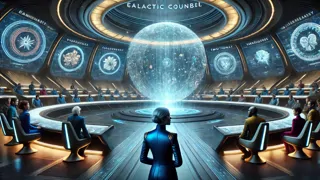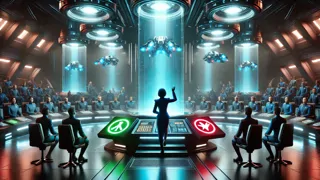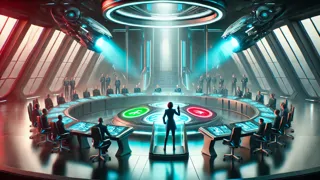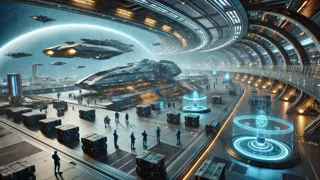Introduction
From the moment Captain Maria Reyes peered through the reinforced viewport of the SS Emissary, she felt the weight of Earth's hopes pressing against her shoulders. Twenty-four thousand light years from home, Ares Station hung like a silver sentinel in the void, its neon corridors threading between decelerating starships. Rumors of conflict between the Tharaxian Collective and the Vezari Syndicate had reached every corner of the United Planets, threatening a war so vast it could engulf multiple star systems. As Earth’s designated Galactic Diplomat, Reyes carried no arsenal but her unwavering resolve and a belief that empathy could outshine the harshest lasers. The docking clamps hissed around the Emissary’s hull, filling the chamber with an otherworldly hum that resonated through her bones. She adjusted her cobalt-blue negotiation uniform, embossed with Earth's seal, and took a steadying breath. Inside her kit sat the Celestium translator, designed to capture the subtlest tonal shifts in alien speech. Beyond the blast door, the low murmur of delegates already prepared their opening statements. Every flicker of holographic signage and echoing footstep signaled a delicate dance of politics and power. A single misstep could unleash lasers lurking in hidden armaments. Reyes recalled her mentor’s warning: 'Wisdom without courage is like a star without light.' Gathering strength from that mantra, she stepped into the corridor. The air tasted faintly of ozone and recycled metal—a signature aroma of frontier outposts. Far above, nebulae thrummed against the darkness, as if the cosmos itself watched her next move. On this day, history would either crown her legacy as peacemaker or condemn her to witness the first volley of interstellar war.
Arrival at Ares Station
The SS Emissary’s thrusters faded as it slipped into Ares Station’s magnetic dock, the silent clamps drawing the ship into the cavernous bay. Fluorescent runes along the curved bulkheads pulsed with discreet warnings, and overhead cranes shifted to clear a path. Technicians in cobalt suits darted between towering freighters and sleek alien vessels, their voices muted by the hum of environmental processors. Reyes watched through the viewport as the outer hull scraped gently against the docking cradle, and the massive airlock doors parted in a hiss of pressurized atmosphere. She took a deliberate breath, savoring the metallic tang and the distant echo of gravity boots clanking across reinforced plating. As the gangway sealed into place, soft white lights illuminated her path, and drones hovered in symmetrical arcs, scanning cargo crates and cargo manifests. The station’s AI welcome chime rang in her ear, announcing her arrival in fourteen different languages at once.

Stepping onto the platform, Reyes was struck by the cathedral-like corridor that stretched before her. Holographic luminescent chandeliers drifted overhead, casting shifting patterns of violet and emerald on polished floors. Walls of transparent alloy offered a view of the star field beyond, where distant suns flickered like pinpricks. The combination of artificial and natural wonder gave the station a living pulse, as though it breathed with the hopes and fears of every being aboard. In the distance, she could make out the faint console chatter of security officers reviewing threat assessments. Even among the lofty promise of peace, tension remained a constant current.
Security protocols ushered her into a streamlined transport pod. The doors closed behind her with a gentle click, and the pod’s interior cycled through mission parameters and environmental calibrations. As the vehicle glided away, Reyes tapped her datapad to review the initial council agenda. Each delegate’s bios linked to intelligence profiles, flagging potential biases, cultural taboos, and historical grievances. At its center lay the looming question: could a lone human voice find common ground between species whose histories were written in blood? The thought tightened her chest, but she reminded herself that empathy could forge alliances stronger than any ion cannon blast.
Trial of Empathy
Once inside the central council chamber, Reyes paused at the threshold to absorb the spectacle. The circular room soared above her, girded by struts of carbon-titanium and inlaid with shifting data streams projected on crystalline panels. Delegates from ten star systems occupied segmented alcoves around the perimeter, each enclave a cultural showcase—floating water bubbles for the Telari, living bioluminescent plants for the Vardun, and hovering stone monoliths pulsing with runic light for the Zharxi. At the center floated the Empathy Conduit, a translucent sphere containing swirling colors that reflected the emotional currents of the room.

A low hum reverberated through the platform beneath her feet as Reyes approached the sphere. Holographic overlays displayed the Conduit’s real-time mapping of neural responses and heart rates. The trial demanded she share an unguarded memory—an act of vulnerability to calibrate the device. Swallowing back nerves, she projected a childhood recollection of her grandmother’s garden under terran moons, describing the scent of blooming jasmine and the comforting hum of nocturnal insects. Warmth spread through the Conduit as it absorbed her words, colors brightening to a soft rose hue. Murmurs floated from the delegates. Some hearts slowed, others seized with unfamiliar understanding.
Moments later, the Tharaxian High Envoy stood, their six eyes luminescent, and voiced tentative respect. But across the room, a Vezari commander’s claws drummed in impatience, betraying a willingness to escalate. The Conduit flickered to a steely blue—an emotional alert of rising aggression. Reyes opened her datapad to a live translation feed, weaving in culturally sensitive analogies about shared loss and hope. She told of Earth’s scars from centuries of war and how unity had allowed humanity to transcend its darkest impulses. As her tone softened, the chamber’s atmosphere shifted. The Conduit’s hue transitioned to gentle green, signaling a fragile accord. Yet Reyes sensed that the real test was only beginning—maintaining this fragile empathy against the undercurrent of fear and ambition that threatened to ignite every laser turret hidden behind the council’s walls.
After hours of exchange, delegates dispersed to private caucuses. Reyes retreated to a small observation gallery, her mind racing with strategy. She recorded observations on body language, tonal inflections, and microexpressions—data she would later use to craft proposals tuned to each species’ core values. Outside the gallery, starfields glimmered like distant promises, reminding her why she fought for peace: because empathy—even in the void of space—had the power to illuminate a path beyond war.
The Choice of Lasers or Peace
As the final summit convened, tension crackled in the chill of recycled air. A glass dais at the chamber’s center held two controls: one to initiate a coordinated laser deterrent across the station, and the other to release a binding peace accord for signature. Delegates assembled behind frosted screens, eyes glittering with equal parts hope and demand. A green indicator light blinked beside the peace option, while a crimson halo surrounded the laser command. Reyes stepped forward, her pulse a steady metronome in the hush.

Before she could speak, alarms blared. Automated turrets hidden in the overhead struts activated, crystalline barrels pivoting toward the dais. Screams of metal scraping and frantic footsteps echoed as security drones scrambled to lock down potential saboteurs. Projection panels flashed: unauthorized breach detected in the station’s central reactor. Every delegate recoiled, suspicion cracking the fragile trust that Reyes had barely assembled. In that moment, she realized that no machine could interpret this emergency with empathy—only her voice could.
Raising her hand, she modulated her tone into solemn calm, broadcasting her speech through every comm channel. She recounted how war’s laser blasts left echoing scars on planets, how no shield could protect the innocent. She invoked the firsthand accounts of Tharaxian farmers who rebuilt whole worlds from ash, and Vezari medics who sheltered refugees of human conflicts. Her words reached past screens and armor, stirring compassion in even the most hardened hearts. One by one, delegates deactivated their turrets. The crimson halo faded, leaving only the green glow of peace.
Moments later, the station AI confirmed the crisis as a reactor malfunction, not an act of aggression. Reyes pressed the peace command. The chamber’s holobridges aligned, joining the signatures of every species present. Outside, Ares Station’s neon glow steadied, its turbines humming in solidarity. In that crucible of laser threat and raw emotion, human empathy had prevailed. The final rays of an alien sun cast multicolored reflections across the dais as the Galactic Diplomat watched a new chapter of interstellar unity unfold.
Conclusion
By the time Captain Maria Reyes truly stepped away from the dais, the echoes of potential conflict had faded into the calm hum of Ares Station’s core. She took one last look at the Empathy Conduit, its swirling lights now steady in the solidarity of twelve newly forged alliances. In her holopad, she recorded final remarks: humanity’s belief in listening had tilted the scales away from lasers and toward understanding. The Celestium translator, once an experimental novelty, had become a bridge between minds, proving that no language barrier was too vast when sincerity led the charge. As the SS Emissary disengaged from the station’s docking clamps and drifted back into the velvet black, Reyes allowed herself a small, proud smile. The United Planets would soon hear that Earth had shown the galaxy another path: one where diplomacy, perspective, and a single courageous voice could avert a war of cosmic proportions. Above the looming nebulae, she knew this was only the beginning of a journey beyond any map—they had steered a course for hope.



















